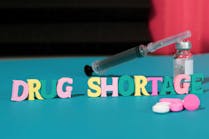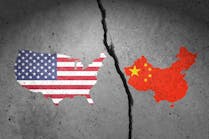If someone were to ask you what 1979 film bore the tagline, “In space no one can hear you scream,” how would you respond?
If you immediately thought of Ridley Scott’s science fiction-horror hybrid Alien then you just demonstrated how much power can be packed into a near-perfect tagline.
Unlike space, the healthcare supply chain can be cold and sterile, but it isn’t a vacuum.
In the healthcare supply chain, everybody can hear you scream, and everyone screaming about and at you due to service failures and interruptions.
Regardless of area, department, service line, specialty or facility, supply chain demands and expectations remain consistent. Some perform well, others not nearly so well.
From a functional supply chain perspective, Pharmacy and Supply Chain (the department) represent two sides of the same coin.
Each can – and should – learn something from the other. Depending on whom you ask either performs certain selected functions rather well. Alternately, either requires some improvement on other functions.
Where do these two distinct areas excel or need more work? Three Pharmacy and Supply Chain experts shared their impressions and insights with Healthcare Purchasing News.
Mary Beth Lang, Sc.D., RPh, serves as Executive Vice President, Cognitive Analytics, Pensiamo, a Pittsburgh, PA-based supply chain services company spun from UPMC where Lang previously ran Pharmacy and Supply Chain. Holly Bones, PharmD., serves as System Director, Pharmacy Procurement & Formulary Services, Geisinger Health, Danville, PA, and Kate Polczynski, CMRP, serves as Associate Vice President, Procurement, Geisinger Health.
What operational and organizational lessons can Supply Chain learn from Pharmacy to help it manage products and services?
Information Technology hardware/software
BONES: The Pharmacy teams emphasize point-of-care bar coding for data accuracy and safe patient care. This use of technology to enhance the care givers accuracy and efficiency is a model Supply Chain teams aim to replicate.
Product data standards
LANG: Most providers strive for 100 percent of administered medications bar-code scanned at the point of care. Since not all medications are bar-coded down to the unit of use, Pharmacy has had to seek automation to affix barcodes or they have worked with outsourced companies to perform this task. Many Supply Chain leaders are considering similar approaches as they implement [Unique Device Identification] as it is clear that the device may be bar coded but many of the related supplies are not. Supply Chain leaders understand that scanning 100 percent of supply use will support larger initiatives such as cost-per-procedure calculations and quality measures.
BONES: As the industry moves towards increased data standards, Supply Chain has followed lessons shared in the Pharmacy NDC space for the benefits of bar coding and consistent part numbers. Global standards, such as GS1’s GTIN, mimic this model to bring these benefits closer to the bedside.
Low-unit-of-measure logistics/storage (e.g., shelving, medication carts)
LANG: Pharmacy has more control of items dispensed as most items are issued only upon review of a physician order for a patient that has been verified by a pharmacist using a closed formulary. Pharmacy has had greater control of supplies on the nursing units and procedural areas. Similar control measures are being added to procedural areas by supply chain.
BONES: Bar-code scanning of medication at the bedside gives visibility into product utilization. This methodology is being pushed to the Supply Chain via the application of GS1 data standards with the goal of achieving similar visibility.
Internal management processes
(e.g., clinical rounds, P&T committees, etc.)
LANG: The formulary process determines what items are clinically acceptable for use in a system. Under a closed formulary, physicians and clinicians must follow strict guidelines for new items to be added to the system. Supply chain leaders are adding this same rigor to clinical categories.
BONES: Pharmacy and Supply Chain have taken the initial steps to align Formulary Addition requests for pharmacy medications and items, and continuing use evaluation (CUE) requests for med/surg items and devices. Pharmacy and Supply Chain collaborate when an item is requested to be purchased to determine if the product meets safety and efficacy standards for not only CUE purposes, but pharmacy purposes as well.
External management processes (e.g., dealing with distributors, GPOs and manufacturers, 340B pricing diversity etc.)
LANG: Pharmacy leaders manage multiple classes of trade across the continuum of care that spans inpatient through home care. In doing so, Pharmacy leaders pay close attention to health plan formularies and approval processes to optimally select products that are approved so that the item is covered at a reasonable co-pay to the patient. This consumer driven approach is being studied by Supply Chain leaders as they expand beyond acute care.
BONES: The traditional Pharmacy focus on patient-first is emphasized and embedded in the day-to-day decision-making process, including all pricing and contracting decisions, overcoming the stigma that Supply Chain “is concerned only about cost.”
Product safety and security (e.g., access, track-and-trace, etc.)
LANG: Pharmacy is in the process of implementing the [Drug Supply Chain Security Act], focused on track-and-trace to eliminate counterfeit products. Health systems with a self-distribution center for pharmacy have had to comply with the DSCSA as a secondary distributor adding the need to track and transmit lot and expiration date for every product shipped. This has necessitated changes to the [warehouse management system] receiving, pick, pack and ship methods. Supply Chain leaders considering self-distribution of devices may benefit from the early learnings of compliance by Pharmacy.
BONES: Pharmacy and Supply Chain have taken a joint ownership of the DSCSA track-and-trace initiative that has been implemented. By working together, a process has been created for the tracking of supply (device, implantable, etc.) and pharmaceuticals to avoid bringing counterfeit products into the supply chain.
Crisis management (e.g., demand forecasting, preventing/managing through distribution issues/stockouts, etc.)
BONES: One recent example of the benefits of collaboration amongst both teams has been the Geisinger response to the national IV solution crisis. The Supply Chain and Pharmacy teams have collaborated to forecast system product needs while ensuring quality patient care is received through conservation education strategies and inventory management modeling to shift allocated product where it is needed most. This comprehensive approach allows a faster response time due to complete visibility into logistics, utilization and clinical strategy. The team recognizes the strengths of each area and leverages them to best position the system for success.
Multi-disciplinary leadership qualities (e.g., should a pharmacist lead supply chain or vice versa? Should the two departments be managed under one leader/organizationally linked?)
LANG: The recent IV fluid shortage has illustrated the collective strength of pulling a multidisciplinary team together to design and implement strategies to continue quality patient care. What started as a shortage of small volume IV fluid bags has grown to an expansive list of supply chain and pharmacy products. The last briefing from the FDA identified over 90 different product categories for over 1,200 individual [stock-keeping units]. Pharmacy deals with over 1,000 different product categories weekly and has had to design a comprehensive infrastructure to address the critical shortages. Part of the infrastructure is to reach out to key physicians, clinicians, nurses, quality and executives as part of the response. Supply Chain brought strong logistics and sourcing expertise to secure alternative products and move product. Pharmacy leaders added the clinical alternatives and operational changes in drug preparations. IV fluids were removed from the units and procedural areas to Pharmacy as Pharmacy has better control and handling of storage, distribution, allocation management and adherence to practice changes.
The collective group designed alternative practice and conservation strategies that have led to consistency in patient care. We have learned a great deal about the differences between the pharmacy supply chain needs as compared to other categories that supply chain management supports.
BONES: Geisinger has taken a unique strategy of partnering Pharmacy with Supply Chain under the umbrella of Care Support Services, led by Deborah Templeton, R.Ph., Chief, System Support Services. Geisinger has achieved both fiscal and operational success with this model recognizing that both areas complement each other in best serving the patient. This collaboration has allowed the Geisinger team to highlight the strengths of each area and develop a comprehensive approach to delivering superior patient care for all supplies, inclusive of drugs, with a patient-centric approach.
On the flip side, what operational and organizational lessons can Pharmacy learn from Supply Chain to help it manage products and services?
Information Technology hardware/software
LANG: Historically, pharmacy ordering was completed through the wholesaler or direct manufacturing ordering sites disconnected from an ERP system. Many health systems are adding pharmacy onto an ERP and connecting to distributors and direct manufacturers and transacting purchasing through the same EDI and marketplace protocols.
POLCZYNSKI: Geisinger has integrated all supply, device and pharmaceutical purchasing into a single ERP, allowing increased visibility into product expenses and utilization patterns. This has also allowed for standardized procedures in product acquisition which helps the system to control costs, ultimately reducing the cost of patient care.
Product data standards
LANG: Pharmacy has benefited from the National Drug Code and AHFS categorization. What has been lacking for Pharmacy is the ability to transact through ANSI 850/855/810 standards. Many pharmaceutical manufacturers have limited ability to accept or confirm purchase orders or to support electronic invoicing. Pharmacy is benefiting by having Supply Chain support discussions and share protocols to extend the ability to fully transact electronically.
POLCZYNSKI: Supply Chain has led the implementation and application of GS1 data standards in to daily process. This has helped Pharmacy prepare for DSCSA track-and-trace regulations. This also includes tracking the Unique Device Identifier from patient use to payer claim to give a 360-degree view of implant performance. This parallels the use of the NDC for drugs in the same way. This allows visibility in to the total cost of care for patients.
Low-unit-of-measure logistics/storage (e.g., shelving, medication carts)
LANG: Pharmacy has had automated dispensing cabinetry for years with the ability to set min/max quantities. Pharmacy has not followed best-in-class same supply chain principles for setting and controlling inventory throughout the system. It is common to have safety stock quantities added in the main pharmacy and at every location where a medication is stocked. At a time when providers are under unprecedented cost control, applying supply chain principles to pharmacy inventory deliver one-time savings and on-going cost avoidance.
POLCZYNSKI: The traditional Supply Chain strengths of price optimization and logistical efficiency enhance the ability to better control the impact of high-dollar pharmaceutical expenses. Tactical strategies such as localized negotiation, bulk purchasing and centralized distribution all perform in harmony in a collaborative model.
Internal management processes (e.g., clinical rounds, P&T committees, etc.)
LANG: Pharmacy leaders are using Supply Chain strategies to determine how best to comply with P&T formulary decisions. For example, instead of purchasing non-formulary medications at each site, consolidated pharmacy services can order a small quantity centrally and then issue in low unit of measure.
POLCZYNSKI: Geisinger has modeled traditional supply chain standardization strategies to develop a closed formulary, which drives consistent and evidence-based drug utilization for all patients across the continuum of care.
External management processes (e.g., dealing with distributors, GPOs and manufacturers, 340B pricing diversity, etc.)
LANG: As recently as three years ago, national wholesalers could fulfill most pharmaceuticals. With the increase of products moving through the third-party logistics channel, limited distribution, [risk evaluation and mitigation strategies], 340B and non-acute class of trade, procurement for pharmacy has become very complex. Pharmacy is learning from Supply Chain how to operate in a series of interconnected markets.
Pharmacy contracting has historically been outsourced to the GPOs and distributors. Many health systems are adding sourcing resources to apply category management practices to pharmacy through direct agreements with manufacturers. Supply Chain brings the expertise of RFPs, negotiations, advanced agreements and risk-sharing strategies.
POLCZYNSKI: An integrated ERP for all procurement, inclusive of pharmacy contracting, has allowed for enhanced contract benchmarking for all supplies and pharmaceuticals. This provides Geisinger the ability to determine where inefficiencies exist and develop cross-functional action plans to eliminate variabilities in pricing and assist in standardizing care.
Crisis management (e.g., demand forecasting, preventing/managing through distribution issues/stockouts, etc.)
LANG: In addition to [what I said earlier] Pharmacy can benefit greatly by procurement automation using best-in-class “touchless or lights out” strategies for issuing POs or payments to distributors and manufacturers.
POLCZYNSKI: Pharmacy and Supply Chain share similar methodologies for managing supply shortages and pharmaceutical shortages. We are also aligned with our disaster preparedness. Analytics tools are utilized to help predict supply needs in advance of stock out/shortages.
Multi-disciplinary leadership qualities (e.g., should a pharmacist lead supply chain or vice versa? Should the two departments be managed under one leader/organizationally linked?)
LANG: Regardless of reporting relationship a matrix of accountability is needed to ensure collaborative practices between Pharmacy and Supply Chain at all levels of leadership.
POLCZYNSKI: Should or could? In reality, it does not so much matter who is the “official” leader. The collaborative relationship with Pharmacy and Supply Chain as well as the matrix model that we currently deploy has multiple points of integration and benefits: including financial, patient safety, and organization efficiencies that are stronger because of the partnership.
Visit www.hpnonline.com/pharmacy-supply-chain-should-not-drive-in-fast-lane/ for an exclusive interview with expert Marv Feldman.

Rick Dana Barlow | Senior Editor
Rick Dana Barlow is Senior Editor for Healthcare Purchasing News, an Endeavor Business Media publication. He can be reached at [email protected].








